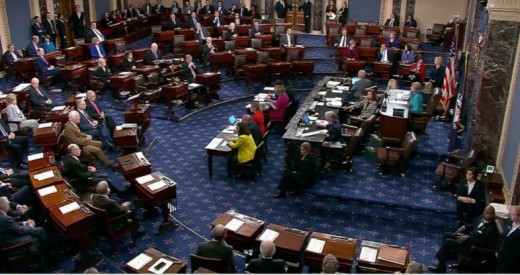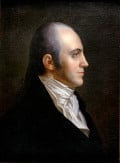The Kavanaugh/Ford Hearing by the Senate Judiciary Committee

Introduction
In order to understand what really happened in the Kavanaugh/Ford hearing held by the Senate Judiciary Committee, it is first necessary to understand some terms used by the Senate. They are:
- Super Majority and Cloture
- Nuclear Option
- The Biden Rule.
All of these terms will be defined by the following text in the context they are used by the Senate.
The Super Majority and Cloture
For many years the senate required a super majority of 60 votes in order to nominate judges, cabinet secretaries, and supreme court justices. However, the super majority rule also had a filibuster rule attached to it that could be used by the opposing side to delay reaching the 60 votes by invoking a filibuster.
A filibuster is an obstructive tactic used in the Senate to prevent a measure from being brought to a vote. The most common form of filibuster occurs when one or more senators attempts to delay or block a vote on a bill by extending debate on the measure. Once the 60 votes are reached, Cloture is invoked and after 30 hours, no more filibustering is allowed and the votes are passed through.
Nuclear Option
This all changed in 2013 when Senate Majority Leader, Harry Reid invoked the Nuclear Option. The nuclear option rule states that only a simple majority of 51 votes is required to get the required nominations passed. Cloture can then be invoked 30 hours after the 51 votes have been achieved. Harry Reid used it to get some federal judges and cabinet secretaries confirmed. But it is important to note, Reid and Obama did not use it to get Merrick Garland nominated to the Supreme Court. Mitch McConnell, the Minority leader of the Senate at the time said something to the effect, "You may have won for the short term, but the nuclear option will come back to haunt you for the long term." Boy was he right!
The Biden Rule
Fast forward to the last months of the Obama’s presidency, the GOP had control of the house and the senate and Obama wanted to nominate Merrick Garland to replace Justice Antonin Scalia. Mitch McConnel who was then the Senate Majority Leader invoked the “Biden Rule” which stated that the vacancy should not be filled until the next president is elected. It should be noted that the new rule was passed by using the nuclear option of only 51 votes.
Nine months later Trump was elected president and Neil Gorsuch replaced the vacancy left by Scalia. You guessed it, McConnell used the nuclear option of 51 votes and no filibuster. He was said to say, "This was one of the best moments in my life."
The Kavanaugh/Ford Hearing
This brings us to the present and the Kavanaugh/Ford Hearing. The purpose of the hearing was to hear from both sides of the aisle as to why Kavanaugh would or would not be qualified to be a supreme court justice and to provide advice and consent to the president based on the findings.
Sometime, prior to the hearing, Minority Leader, Diane Feinstein received a letter from Dr. Ford describing how Dr. Ford had been sexually assaulted by Kavanaugh when they were both teenagers. At the hearing, Dr. Ford was sworn in under oath and made an opening statement. Also brought into the hearing was a female prosecutor who was experienced in prosecuting sexual abuse cases. She was allowed to question Dr. Ford based on her allegations of sexual abuse by judge Kavanaugh at the time.
After Ford's testimony, judge Kavanaugh was sworn in and gave his opening statement. He then gave his testimony and swore under oath, that he was innocent of all charges presented by Dr. Ford.
Senator Jeff Flake then made a motion to have the FBI investigate both parties as a result of two women approaching him in an elevator while he was on a break. At that point, the hearing was stopped as the motion was passed. Trump then agreed to an investigation that was limited in time and narrow in scope. The investigation yielded nothing new other than there was no corroborative evidence to support Dr. Ford’s allegations of sexual assault. Judge Kavanaugh was then confirmed as the Supreme Court Justice to replace Judge Kenndy's seat on the bench.
My analysis
- In accordance with Article 1 of the Constitution, the primary purpose of the hearing by the Senate Judiciary Committee was to provide advice and consent to Trump on the nomination of Judge Kavanaugh to the Supreme Court.
- Mitch McConnell had already made up his mind that the judge would be confirmed barring any unforeseen circumstances.
- Diane Feinstein’s letter by Dr. Ford was presented at the "11th hour" to the committee. Therefore, as a matter of optics, a female prosecuting attorney was brought in to question Dr. Ford. Once Senator Graham presented his tirade about how the hearing was a sham, the attorney did very little questioning of Judge Kavanaugh.
- The FBI investigation was a sham because it was limited in time and scope and they never questioned any of the other outstanding witnesses who had come forward to vouch for Dr. Ford’s testimony.
- The nuclear option, is now part of the standing rules of the Senate. It is really a simple majority. The reason it is called the nuclear option is because like a detonation of a nuclear bomb, it can have fallout on both sides of the aisle, depending on what party is in control of the senate.
- When Harry Reid used it for the first time. Mitch McConnell knew it would just be a matter of time before the GOP was in control of the senate and he could use it to make the Biden Rule and the simple majority part of the standing rules of parliamentary procedure.
- He then used the Biden Rule to stall nine months until Trump was elected and Neil Gorsuch was confirmed to replace Scalia; thus, blocking the nomination of Merrick Garland. He then used the simple majority to have Judge Kavanaugh replace Kennedy as a Supreme Court Justice.
- In accordance with Article 1, section 5, clause 1 of the Constitution, congress can make and change their own rules of order. All it takes is a quorum to be present.
- Harry Reid used the simple majority to confirm federal judges of the lower court and some cabinet secretaries, but he never used it to confirm a supreme court justice. That still required the super majority for confirmation.
- Even though it was evident that one party was not telling the truth and both were under oath, the committee never charged either party of perjury. Because that was not the purpose of the Judiciary Committee; it was to provide advice and consent to the president. Some argued that in a court of law, presumption of innocence is the rule of law. However, this was not a court of law, it’s purpose was to provide advice and consent to the president.
- It is evident that both sides use manipulative tactics to gain an advantage, it just is matter of which side controls congress as to how that advantage plays out.
Who do you believe was telling the truth?
Do you believe the FBI investigation was complete enough to come to a conclusive determination of either party?
© 2018 Mike Russo







